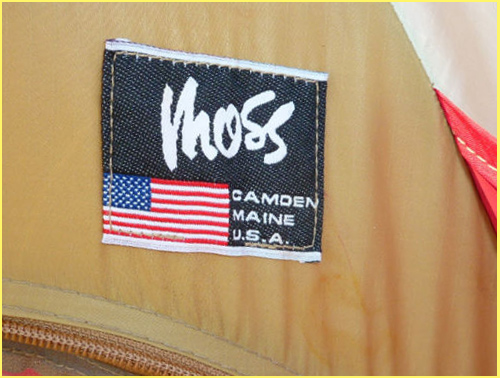

Moss Tent Works founded 1975-76 by C. William Moss in Camden, Maine. Moss Tents have an intense fan following and most models/vintages are highly collectible if they are in good shape.... Here's a link to a Moss timeline, as completed by a colleague of mine: http://homepage.mac.com/inov8/Compass/mosshistory.html-- the reader should especially note that Bill Moss was the original inventor of the now-famous "Pop-Tent," That was in 1955, at a time predating everyone else in the U.S. except Roy and Alice Holubar and Gerry Cunningham, and of course the ultra-venerable Eureka Tent Company..... Below is the label from a very early model Pop Tent. You see that the fabric was a heavy cotton duck or the like. The poles were steel. For all its charm and other merits of convenience, the Pop Tent was far too bulky and heavy to ever carry as a backpacker's tent. The nylon and aluminum tents of GERRY and Holubar were far more appropriate for hikers and climbers.
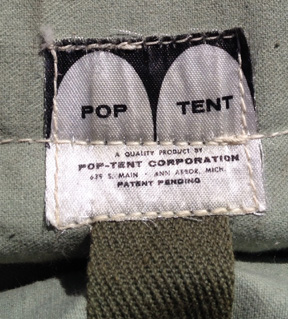
Big book about Bill Moss was published 2013. The writer, Marilyn Moss, former CEO of Moss Inc., sent me a copy to review. The book is titled "Bll Moss Fabric Artist & Designer" ISBN: 987-0-9892393-0-1, price: $60 USD. It is 301 pages, "10 x 11.25" format, chock full of color photography and other image content, covering not just Moss' considerable accomplishments in tent technology and design, but his personal history, his large-scale tensile structures, and his legacy in general, which is huge. Click here to read my review of the book.
Bill Moss, born 1923, passed away in October 8, 1994, in Scottsdale, Arizona.
2000-probably the date after which the "Moss" label was dropped from tents because MSR bought up the Moss tent designs. A company named Edgeworks had been manufacturing the Moss, Walrus and Armadillo tents in the interim after Moss tents stopped being made in Camden, Maine. A note of interest: the founders of Sierra Designs were quite involved in Walrus Tents, especially co-founder Bob Swanson....Click to access my six pages about the history of Sierra Designs.
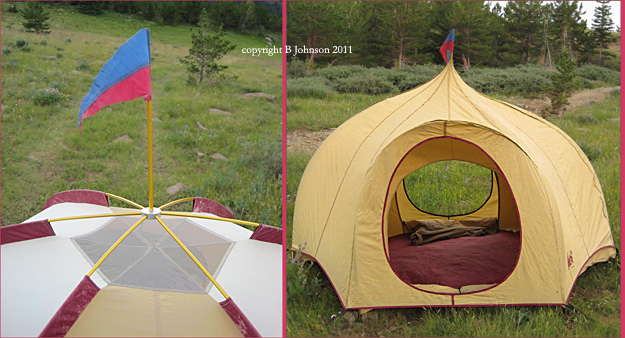 with & w/o rainfly
with & w/o rainfly
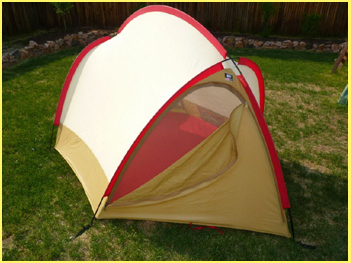 Why are Moss tents so revered? Here
is my paraphrase of what one Moss expert wrote recently: Moss
tents were made with the ultimate attention to detail and durability.
Although Moss tents were not designed with a goal of being lightweight,
they are known for long-term durability and longevity. There is
still a strong following for these tents in Maine and even worldwide,
and especially in Japan.... They were first manufactured in Camden,
Maine, and for a long time one could still get parts made and
repairs from a small company in Camden which was composed of several
ex-employees of Moss! That resource is gone now (2020). (Click Link). --- Lastly, apparently Moss was
unique in the tent industry in offering a “Double Guarantee,”
where not only did their tents carry a lifetime warranty (like
several other of the major brands had), but uniquely Moss had
a buy-back policy, too, that said they'd buy the tent back from
you if you were dissatisfied with it!
Why are Moss tents so revered? Here
is my paraphrase of what one Moss expert wrote recently: Moss
tents were made with the ultimate attention to detail and durability.
Although Moss tents were not designed with a goal of being lightweight,
they are known for long-term durability and longevity. There is
still a strong following for these tents in Maine and even worldwide,
and especially in Japan.... They were first manufactured in Camden,
Maine, and for a long time one could still get parts made and
repairs from a small company in Camden which was composed of several
ex-employees of Moss! That resource is gone now (2020). (Click Link). --- Lastly, apparently Moss was
unique in the tent industry in offering a “Double Guarantee,”
where not only did their tents carry a lifetime warranty (like
several other of the major brands had), but uniquely Moss had
a buy-back policy, too, that said they'd buy the tent back from
you if you were dissatisfied with it!
(June 2019) Lolly, a correspondent
in England sent me this picture of her 4-man Moss Little Dipper
in use under harsh winter conditions in Germany. She reports that
she has used it in windy conditions where all the other tents
went down, "I have used it in the windiest of conditions
in Wales, where my tent was the only one left standing in the
mornng." And in snowy conditions in the Cairngorm Mountains
of Scotland, "where it had a foot of snow fall on it in the
night" with no ill effects. Although these tents weren't
designed as expeditionary tents, they are plenty strong, especially
the dome style ones like the Big and Little Dippers, the designs
of which looks like a true geodesic design (I once owned a big
Dipper).

2000-- Moss brand is discontinued and tents are labelled MSR. Apparently MSR bought the Moss tent patents when the company went out of business....See link to my pages about the history of MSR.
2001--- MSR becomes part of Cascade Designs (maker of the famous Therm-A-Rest camping mattress). They are based in the southern part of Seattle.
Currently: Moss, Inc. has a website, which writes, "The story of Moss begins with a 20th century visionary: Bill Moss, an artist and industrial design wizard who invented the technology of "tensioned fabric". Bill designed and patented the first "pop-up" tent in 1955. In 1983, Moss brought its expertise in curvilinear designs in lightweight fabric and frame to the Outdoor Retailer Show as a backdrop for their display tents..." Source: website Mossinc.com
In some ways it is difficult to say when
"real" Moss tents stopped being made; some say the answer
is simply to look at the label on the tent; if it says "Moss"
then it counts as a real Moss tent, in terms of collectibility.
Others say the most highly desireable Moss tents have the "Camden,
Maine" labels. The status of the Moss labels that say "Seattle"
represent a more uncertain thing for collectors-- however, still
important and collectible....Finally, I have noticed that some
of the older MSR tents that are clearly Moss tent Camden in origin
are selling for quite amazing amounts of money on eBay lately
(2019).
If your main interest is in finding MODERN companies which can supply you with the fabrics and down that you need for outdoor sewing projects, click here to visit my page about that important subject!
Please Note: All Material on this page, and in all my "History of Gear" webpages, is copyrighted, and no usage of my material is permitted unless explicit permission is granted by me, Bruce B. Johnson, owner of OregonPhotos.com. I welcome readers contacting me at oldgear@oregonphotos.com with information, pictures or stories about their classic Gear, or about any of the classic outdoor companies. The Moss tent pictures above were contributed by readers and myself. A contributor in Colorado I especially thank for his fine selection of Flagship pictures.
..... I am researching this company's history; Additional reader input is solicited. Click to email me.
ri
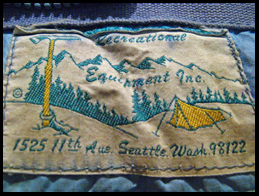 Classic Labels: I am always adding
to this page full of classic, old equipment labels and readers
are welcome to contribute. Here's a label from one of the
first companies in the USA to supply climbers and backpackers:
it's an REI label from sometime in the 1960s, well before the
era when the little climber's cooperative of Seattle exploded
into a corporate giant (Recreational Equipment Inc.)..Click here for my REI
page.... You'll
note the tent shown is a primitive guy-lined A-frame, and the
ice axe is wooden-shafted and with the old-fashioned pick/adze--
the axe in particular is a sign that this label dates from well
before REI's neighbor in Tacoma had perfected the metal-shafted
axe (Larry Penberthy's MSR, aka Mountain Safety Research; click
for two pages about
MSR . (image contributed
by Monte Dodge).
Classic Labels: I am always adding
to this page full of classic, old equipment labels and readers
are welcome to contribute. Here's a label from one of the
first companies in the USA to supply climbers and backpackers:
it's an REI label from sometime in the 1960s, well before the
era when the little climber's cooperative of Seattle exploded
into a corporate giant (Recreational Equipment Inc.)..Click here for my REI
page.... You'll
note the tent shown is a primitive guy-lined A-frame, and the
ice axe is wooden-shafted and with the old-fashioned pick/adze--
the axe in particular is a sign that this label dates from well
before REI's neighbor in Tacoma had perfected the metal-shafted
axe (Larry Penberthy's MSR, aka Mountain Safety Research; click
for two pages about
MSR . (image contributed
by Monte Dodge).
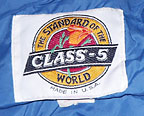 of
California
of
California****************************************************************************************************************************************
Moss book by Marilyn Moss, published by Chawezi, Camden, Maine, 2013. 301 pages. Review by Bruce B. Johnson M.A.
"BILL MOSS, FABRIC ARTIST & DESIGNER"
For over ten years I'd been busy researching
and writing about the histories of the great American outdoor
gear companies and their founders. Why was I then so unfamiliar
with the name of Bill Moss? This took some time for me to understand.
My focus had always been on the evolution of gear since World
War II, and to me that was gear for hiking, backpacking, recreational
climbing and expeditionary climbing. In that sphere, the pioneers
were such well-known companies as Holubar Mountaineering, North
Face, GERRY Mountain Sports, and others of like persuasion. But
as I read Marilyn Moss' tribute to Bill Moss and his long career,
I came to understand that Bill Moss had moved in very different
circles. Those circles had more to do with architecture, art,
portable living structures, and car-camping. The main connection
with the gear and gear pioneers that I was more familiar with
was Moss Tent Works (1975-1993, in Camden, Maine). Once I had
this clear in my mind, I found the book to be very successful
in supporting its title with both written and lush graphic content.
Ms. Moss and her collaborators do a thorough job of outlining in words and images the life work of Bill Moss as a fabric artist, master tent-maker, designer of small, medium and enormous tensile structures, and, finally, his importance as a mentor to a new generation of creative designers and artists. Along the way, the book does a great job at impressing the reader with Moss' genius and influence.
The overall objective of the book seems
to be that of a tribute to the life and work of Bill Moss. As
such, it is not a comparative history or critical analysis of,
for example, Moss tents vs. those of the other great tent designers
before and after him. Moss' merits stand on their own in this
book, and numerous they are. I now want to live in an O'Dome,
or maybe an Op 200. Bill Moss' words on page 129 ring in my mind,
"A tent to me is a piece of sculpture you can get into."
Many thanks for Marilyn and her collaborators for bringing to
the public eye Bill Moss' work and life before it could be lost
to history.
Bruce B. Johnson M.A.
The History of Gear Project
www.historyofgear.com
Since 1997
*********************************************************************************************